This annotated view of a portion of Pluto’s Sputnik Planum (Sputnik Plain), named for Earth’s first artificial satellite, shows an array of enigmatic features. The surface appears to be divided into irregularly shaped segments that are ringed by narrow troughs, some of which contain darker materials. Features that appear to be groups of mounds and fields of small pits are also visible. This image was acquired by the Long Range Reconnaissance Imager (LORRI) on July 14 from a distance of 48,000 miles (77,000 kilometers). Features as small as a half-mile (1 kilometer) across are visible. Credits: NASA/JHUAPL/SWRI
See 3 image mosaic below[/caption]
A vast, hundreds of miles wide craterless plain of Plutonian ice no more than 100 million years old and centered amidst Pluto’s big ‘heart’ was unveiled in spectacular new imagery taken by NASA’s resounding successful New Horizons mission, during its history making rapid transit through the Pluto-Charon binary planet system barely three days ago, on Tuesday, July 14.
The jaw dropping new imagery of young plains of water ice was publicly released today, July 17, by NASA and scientists leading the New Horizons mission during a media briefing, and has already resulted in ground breaking new scientific discoveries at the last planet in our solar system to be visited by a spacecraft from Earth.
“We have now visited every planet in our solar system with American spacecraft,” said NASA Administrator Charles Bolden. “These findings are already causing us to rethink the dynamics of interior geologic processes.”
New data and dazzling imagery are now from streaming back some 3 billion miles across interplanetary space to mission control on Earth and researchers eagerly awaiting the fruits of more than two decades of hard labor to get to this once-in-a-lifetime opportunity.
“I can’t wait for the new discoveries!” exclaimed Bolden at today’s media briefing.
“Over 50 gigabits of data were collected during the encounter and flyby periods,” New Horizons principal investigator Alan Stern of the Southwest Research Institute, Boulder, Colorado, said during the media briefing.
“So far less than 1 gigabit of data has been returned.”
It will take some 16 months for all the Pluto flyby data to be transmitted back to Earth.
And the team has not been disappointed because the results so far shows Pluto to possess tremendously varied terrain that “far exceed our expectations.”
Video Caption: In the center left of Pluto’s vast heart-shaped feature – informally named “Tombaugh Regio” – lies a vast, craterless plain that appears to be no more than 100 million years old, and is possibly still being shaped by geologic processes. This frozen region is north of Pluto’s icy mountains and has been informally named Sputnik Planum (Sputnik Plain), after Earth’s first artificial satellite. Credits: NASA/JHUAPL/SWRI
Two new high resolution images captured by the probes Long Range Reconnaissance Imager (LORRI) on July 14 were released today and taken from a distance of 48,000 miles (77,000 kilometers). Features as small as one-half mile (1 kilometer) across are visible in the images – shown above and below.
They were snapped from frozen region lying north of Pluto’s icy mountains, in the center-left of the heart feature, informally named “Tombaugh Regio” (Tombaugh Region) after Clyde Tombaugh, who discovered Pluto in 1930.
“This terrain is not easy to explain,” said Jeff Moore, leader of the New Horizons Geology, Geophysics and Imaging Team (GGI) at NASA’s Ames Research Center in Moffett Field, California.
“The discovery of vast, craterless, very young plains on Pluto exceeds all pre-flyby expectations.”
“The landscape is astounding. There are a few ancient impact craters on Pluto. But other areas like “Tombaugh Regio” show no craters. The landform change processes are occurring into current geologic times.”
“There are no impact craters in a frozen area north of Pluto’s icy mountains we are now informally calling ‘Sputnik Planum’ after Earth’s first artificial satellite.”
‘Sputnik Planum’ is composed of a broken surface of irregularly-shaped segments. The polygonal shaped areas are roughly 12 miles (20 kilometers) across, bordered by what appear to be shallow troughs based on a quick look at the data.
Notably, some of the clumps are filled with mysterious darker material. Hills are also visible in some areas, which may have been pushed up. Etched areas on the surface may have been formed by sublimation process where the water ice turns directly from the solid to the gas phase due to the extremely negligible atmosphere pressure.
In some places there are also streaks that may have formed from windblown processes and pitted areas.
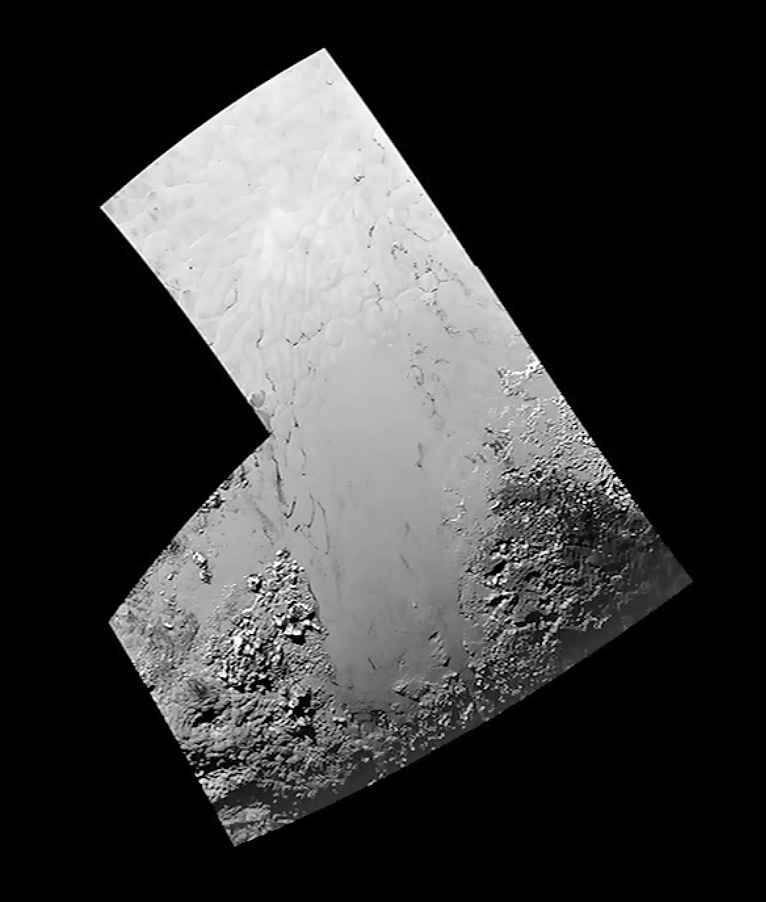
“It’s just pure coincidence that we got the highest resolution data at Sputnik Planum which is of the most interest scientifically,” Moore noted.
Moore indicated that the team is working on a pair of theories as to how these polygonal segments were formed.
“The irregular shapes may be the result of the contraction of surface materials, similar to what happens when mud dries. Alternatively, they may be a product of convection, similar to wax rising in a lava lamp. On Pluto, convection would occur within a surface layer of frozen carbon monoxide, methane and nitrogen, driven by the scant warmth of Pluto’s interior,” Moore explained.
Pluto’s polygons look remarkably similar to the Martian polygons upon which NASA’s Phoenix lander touched down on in 2008 and dug into. Perhaps they were formed by similar mechanisms or difference ones, contraction or convection, Moore told me during the briefing.
As of yesterday, New Horizons spacecraft completed and exited the Pluto encounter phase, said Stern. “We are now collecting departure science.”
New Horizons is already over 3 million miles beyond Pluto and heading to its next yet to be determined target in the Kuiper Belt.
“With the flyby in the rearview mirror, a decade-long journey to Pluto is over –but, the science payoff is only beginning,” said Jim Green, director of Planetary Science at NASA Headquarters in Washington.
“Data from New Horizons will continue to fuel discovery for years to come.”

Stay tuned here for Ken’s continuing Earth and planetary science and human spaceflight news.
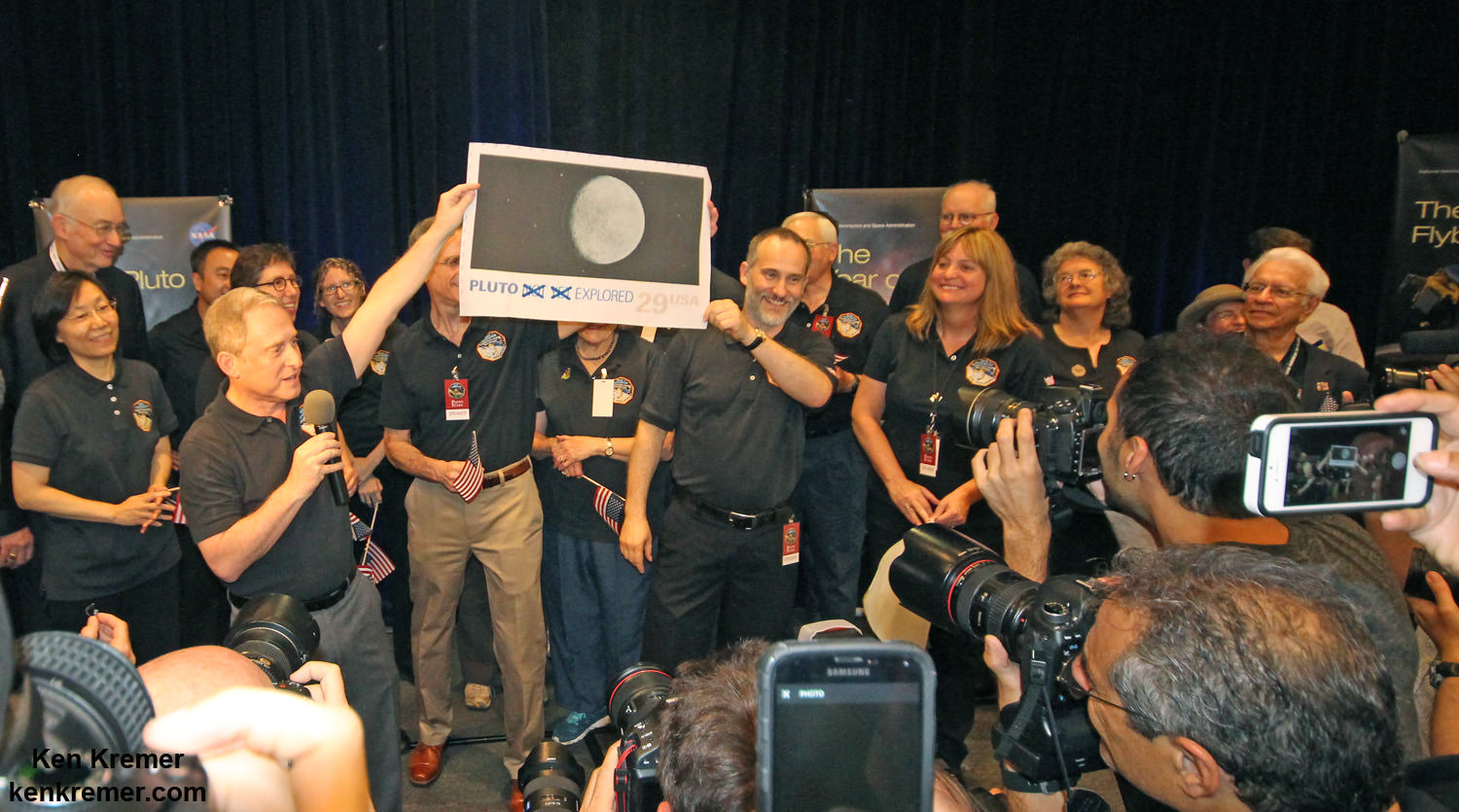
The New Horizons mission team celebrates successful flyby of Pluto in the moments after closest approach at 7:49 a.m. EDT on July 14, 2015. New Horizons Principal Investigator Alan Stern of Southwest Research Institute (SwRI), Boulder, CO., left, Johns Hopkins University Applied Physics Laboratory (APL) Director Ralph Semmel, center, and New Horizons Co-Investigator Will Grundy Lowell Observatory hold an enlarged print of an U.S. stamp with their suggested update after Pluto became the final planet in our solar system to be explored by an American space probe (crossing out the words ‘not yet’) – at the Johns Hopkins University Applied Physics Laboratory (APL) in Laurel, Maryland. Credit: Ken Kremer/kenkremer.com
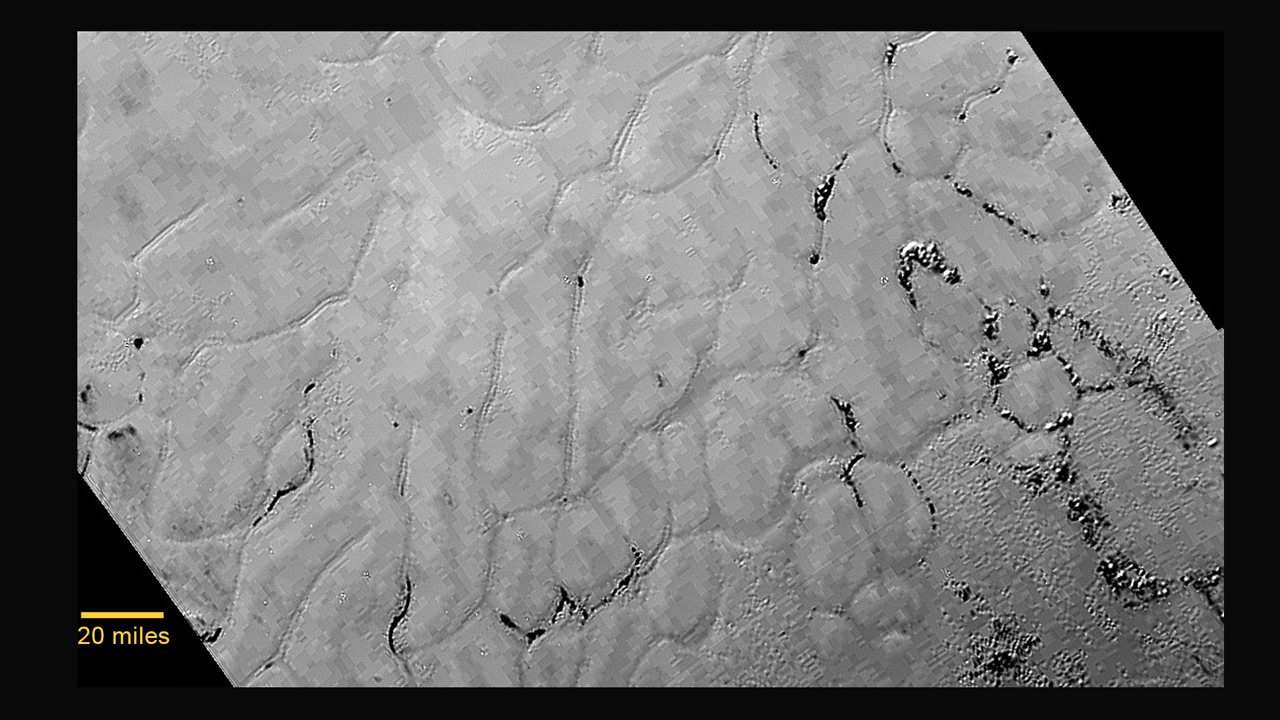

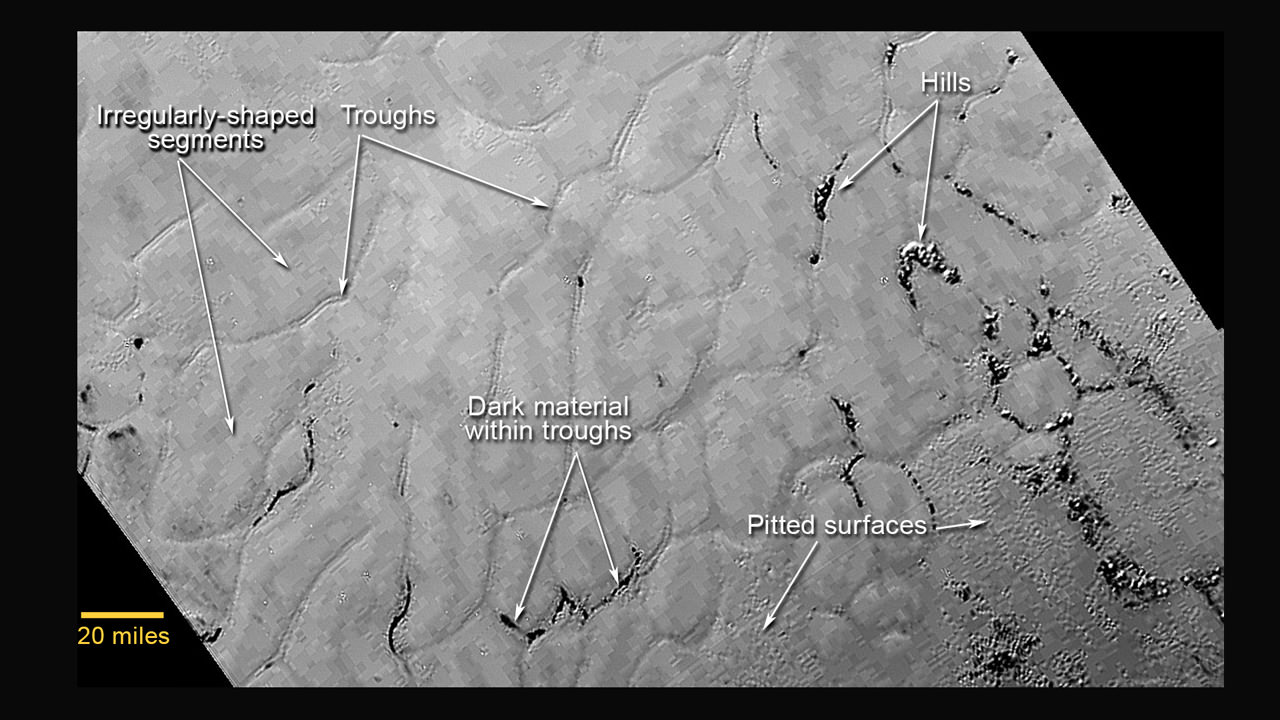
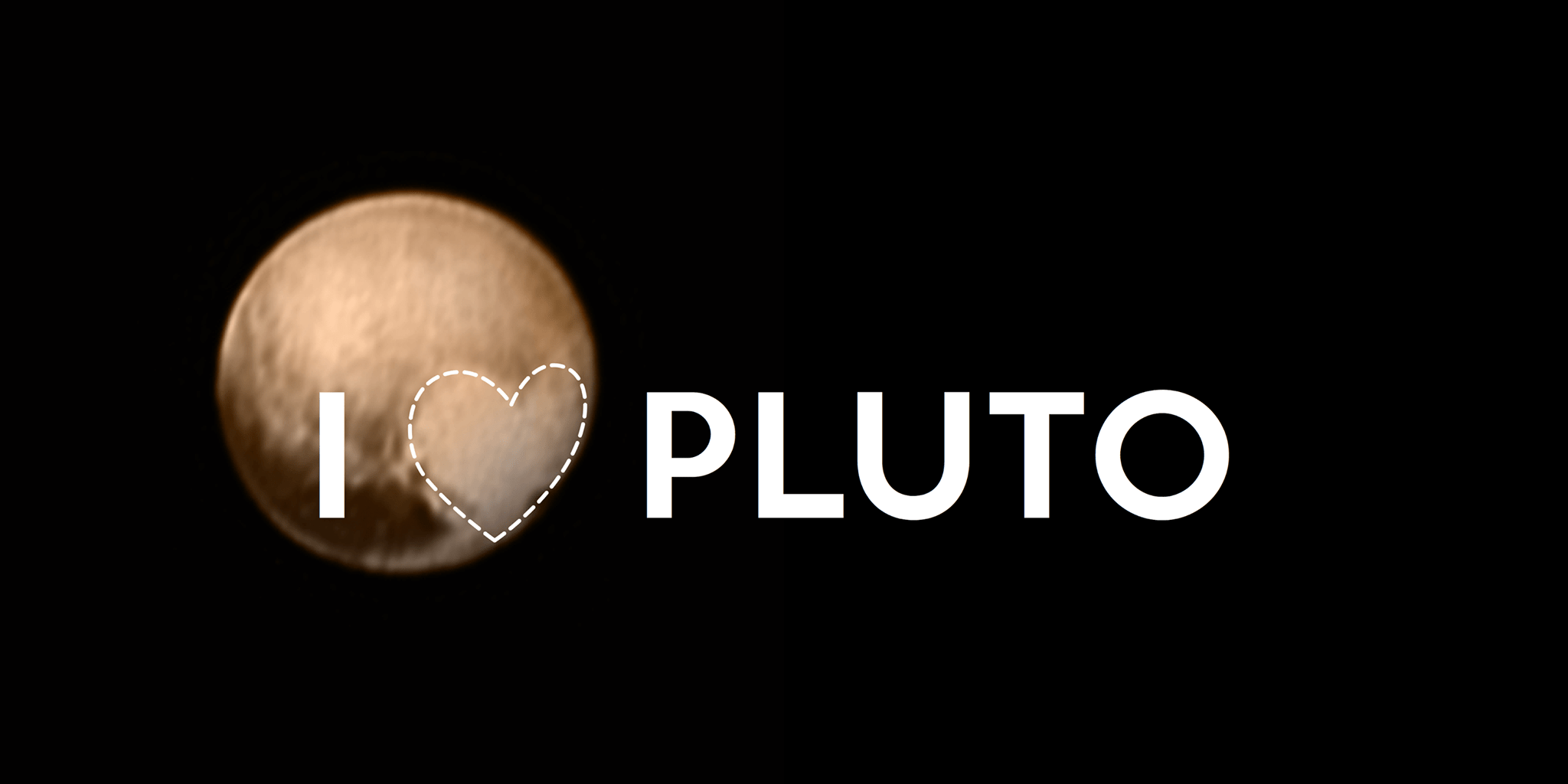
Those pitted surfaces sure look like footprints and tail-drag marks. 😛
Whatever it was would have swallowed Godzilla as an appetizer…
It looks to me like the “runny lava” on Hawaii, which freezes over immedeately after coming to the surface… and now replace “lava” with another more frost resilliant liquid 😉
Could be! I guess the technical term for that would be cryo-pahoehoe.
Aa would be more pitted. Pahoehoe is more like billowing or ribbony sheets. Though, “Cryopahoehoe” is a LOT more fun to say than “Cryoaa” 😉
The rougher parts to the lower right (among the ‘footprints’) might be cryoaa, but I think TedH is right – the billowy, smooth areas look like cryopahoehoe.
Who would have expected Pluto to look like Hawaii? 😛
Grrrrrreat show!
Keep it coming, Ken!
Indeed! Thank you for your prolific stream of detailed information!
Thank you! more upcoming!
I can’t get enough of this stuff. Thanks for putting it all in one place!
WHAT is that dark material between the raised units? We’ll soon know…
Could multi-layered cryogenic phase transition(s) supply the energy behind the resurfacing? Boil at -243 degrees F? Ice XVI anyone?
For the sake of any sample return missions, let’s hope it’s NOT Ice 9! 😉
These images are really full of challenges, The assumption is that Pluto formed from smaller bits of rubble accreating and then becoming spherical due to “internal gravity”. Perhaps Pluto’s surface is not as young as we might think, perhaps it is not in the shooting gallery and therefore not hit so much. Maybe its outer layer was formed by more recent accreations. Time to think outside the box.
The complexity of these smaller bodies, the questions and answers, is what drives planetary exploration.
Roseland Observatory.
Would it not make more sense to follow scenarios caused by known processes first, before considering any new ones? Isn’t that basic problem solving? There is a tried-and-true millennia old process to discovery… Though your “outside the shooting gallery” idea is really interesting. I see you’re an astronomer, so you know more about all this than I. IS there a known or theorized outer limit to the bombardment eras’ physical boundaries?
Of course known scenarios must be explored first, however the surface of Pluto has the specialists mystified at this time. Hence the thought that we ought to perhaps look wider if the known scenarios don’t supply an answer. I am sure we both agree re basic problem solving, it is a question of time scale really.
Re bombardment eras etc. Most of our understanding relates to the inner solar system, there are a number of suggestions re the outer solar system, however none, as I understand it, universally accepted.
Could it have something to do with Pluto being in orbital resonance with Neptune, clearing the orbit for it?
This looks obvious to me like Rayleigh–Bénard convection.
The lines are where the convecting material sank. The dark material and hills look to me like floating icy «froth» traped there because unable to sink, like ice on water. It should have burst very violently from the deep and got frozen that way also very rapidly, but not enough to avoid convection patterns to be drawn. It didn’t erupt geyser-like like Enceladus but was instead liquid-slushy. It was rather a sudden eruption on a large scale made by simulataneous widening of cracks in Pluto’s crust or you would see overlapping spots. It also suggests that deep beneath, there was still liquid stuff.
I suggest Pluto got crossed (hit?) by a massive object that deformed its crust until cracks openned and allowed deep material to rise and spill.
That said, I think such a massive object could / should have disturbed Pluto’s satellites orbit and got them eccentric and inclined. Unless Charon is the culprit… Could this be a hint about Charon’s origin as a captured KBO? Charon could have done this. and with enough time in a close orbit around Pluto, it could have greatly affected Pluto’s rotation to what we see today.
Actually, there is also another explanation, not involving Charon’s capture. Since Pluto and Charon are tidally locked, they are condemned to slowly spiral toward each other. Since it gets closer, tidal force stretchs both’s crust… Because Charon is smaller than Pluton, it is also completely solidified so it doesn’t have liquid anymore under its surface. But logically, Pluto being more massive, it kept liquid stuff under the surface much longer than Charon. That could also explain some of the structures (long canyons) on Charon.
16 months to completely send a few hours’ or a couple days’ worth of data? That’s one Hell of a communications bottleneck.
No broadband on Pluto yet… apparently just 1 to 2 kbps!
A 12-watt transmitter, 5 light hours and the inverse-square law make for a very weak signal!
It would have cost a fortune to launch a more powerful transmitter and bigger power supply. But massive storage is light and cheap, so that’s the way they went.
Pluto is just barely doable with current technology – at least within a realistic budget – so a lot of compromises had to be made. I’m amazed they pulled it off at all.
A shallow* water mantle liquified by tidal heating before Pluto and Charon became tidally locked might have expanded as it froze, creating those chasms on Charon’s surface.
Pluto’s mantle is likely still plastic (judging from those billowy regions – they sure look like recent upwellings) – so that wouldn’t have happened yet because the crust is (apparently) still being resurfaced.
*deeper water will freeze into forms of ice which don’t expand as they freeze.